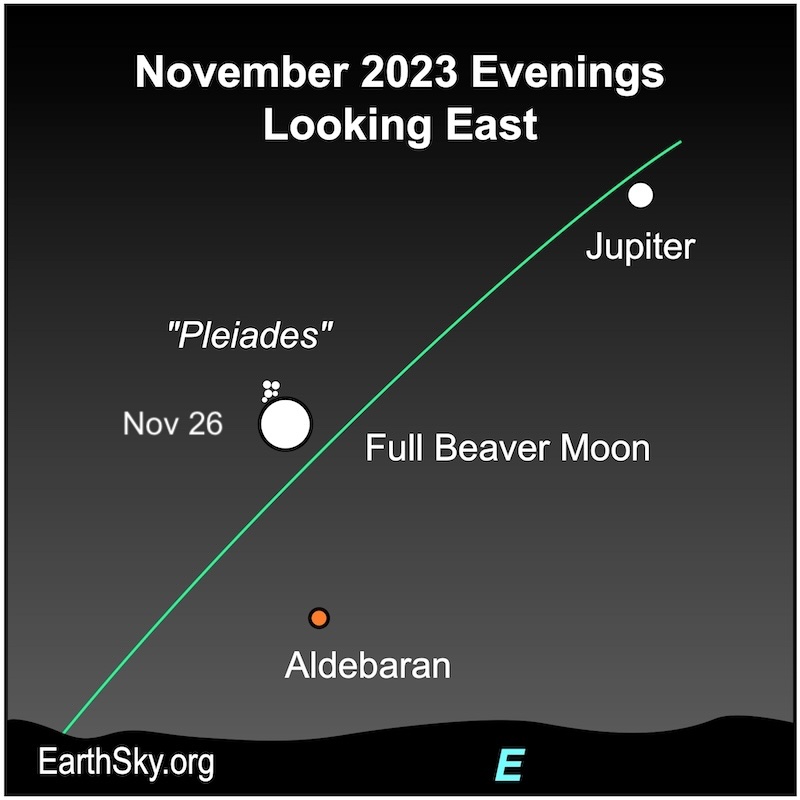[ Skywatchers ] [ Main Menu ]
47763
From: Eve, [DNS_Address]
Subject: Full Moon Monday November 27th, Constellation Taurus
|
Moon in Taurus, Earth in Taurus. Full Moon MON, 27 NOV 2023 AT 03:16 CST (09:16 UTC) The Moon will reach full phase. At this time of the month, it is visible for much of the night, rising at around dusk and setting at around dawn. --The Beaver Moon-- The sequence of full moons that fall through the year are sometimes assigned names such as the "Beaver Moon", according to the months and seasons in which they fall. This practice has been popularised in recent decades by the Farmers' Almanac in the United States. The names used by that almanac claim to have ancient origins from Native American tribes. This claim has been examined in detail by Patricia Haddock's book Mysteries of the Moon (1992) and is partially true, but the selection of names is largely arbitrary. Throughout history a great variety of different names have been given to the sequence of lunar cycles through the year, and modern lists of such names, such as those popularised by the Farmers' Almanac, tend to inevitably be a medley of names taken from many different cultures. According to the Venerable Bede's De temporum ratione (The Reckoning of Time; 725 AD) – an authoritative account of the calendar used in Saxon England – the lunar month containing the third full moon after the September equinox (within autumn) was called the "month before Yule (Ærra Gēola)". The biography of Charlemagne (circa 817–833 AD), written a few years after his death, gives a name of the "holy month (Hailag-mānod)" for the same lunar month. However, in the scheme followed by the Farmers' Almanac, which has become rather widely quoted, any full moon in the month of November is called the "Beaver" Moon. Observing the Moon in coming days Over the nights following 27 November, the Moon will rise around an hour later each day, becoming prominent later in the night. Within a few days, it will only be visible in the pre-dawn and early-morning sky. By the time it reaches last quarter, a week after full moon, it will rise in the middle of the night and set at around noon. The exact moment of full moon The exact moment of full moon is defined as the time when the Moon's ecliptic longitude is exactly 180° away from the Sun's ecliptic longitude, as observed from the center of the Earth. However, the Moon does not appear in any way special at this instant in time, and a full moon can be observed at any time of night. At the moment it reaches full phase, the Moon will lie at a declination of 24°20'N in the constellation Taurus . It will lie at a distance of 380,000 km from the Earth. The chart below shows the size of this month's full moon in comparison to the largest (perigee) and smallest (apogee) possible apparent size of a full moon, drawn to scale. (go to link for scale visual) The celestial coordinates of the Moon at the time it reaches full phase will be: Object Right Ascension Declination Constellation Angular Size The Moon 04h07m30s 24°20'N Taurus 31'23" |
47766
From: ryan, [DNS_Address]
Subject: Re: Full Moon Monday November 27th, Constellation Taurus
| nice moon/jupiter conjunction last night... |
Responses:
[47769]
47769
From: Eve, [DNS_Address]
Subject: Re: Full Moon Monday November 27th, Constellation Taurus
|
I missed it as I was otherwise occupied inside last night ....I did go out tonight and see the Moon and Jupiter even though the conjunction has passed it was a pleasant sight to see peeping through a few puffy scattered clouds. |
Responses:
None
47764

From: Eve, [DNS_Address]
Subject: Re: Full Moon Monday November 27th, Constellation Taurus + Pleiades
|
EXCERPT: Although difficult to see due to the brightness of the moonlight, Sunday night into Monday morning, November 26 to 27, 2023, the Pleiades star cluster will appear just a few degrees from the full Moon. As mentioned above, the next full Moon will be Monday morning, November 27, 2023, at 4:16 AM EST. from: mNASA Daily Skywatching Guide + EXCERPT: from earthsky.com: Image caption: The November full moon will fall on November 26-27, 2023. The blazing planet Jupiter – biggest world in our solar system – will lie nearby, as will red star Aldebaran, Eye of the Bull in Taurus. And, if you look closely, you might also find the tiny Pleiades star cluster – aka the 7 Sisters – in the moon’s glare. The moon will sweep only about a degree – or 2 full moons side-by-side – from the Pleiades on this night. Try watching for the Pleiades with your binoculars. Start looking in evening twilight, when the moon’s glare will be less intense. Chart via John Jardine Goss/ EarthSky. ---November full moon is Beaver or Frosty Moon--- All the full moons have popular nicknames. If the full moon in November falls before November 7, it’s called the Hunter’s Moon. Otherwise, as in 2023, you can call November’s full moon the Beaver Moon, or Frosty Moon. In November, North American beavers are preparing their dens – and stocking up on food – for the coming cold months. We also hear the name Digging Moon for this November full moon, because of the last chances for seasonal foraging by forest animals. |
Responses:
None
[ Skywatchers ] [ Main Menu ]